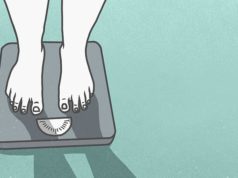Remember when you committed to that new workout plan and your enthusiasm and motivation were through the roof? "Sunday meal prep? DIY cauliflower rice? 5 a.m. workout? F*** yeah!" But then several weeks or months in, you start to notice more takeout orders creeping in. Or, despite a difficult breakup with sugar, you find yourself eating ice cream standing in front of the freezer. Those morning workouts? Not happening-and you haven't really found another way to fit exercise into your daily routine. (Shaun T calls this motivation plateau an "implementation dip.") In short: You've lost the motivation to work out and that's keeping you from reaching your goals, whether they're to lose weight, eat a little cleaner, or build the strength to run that race.
It's frustrating, but it's also common. The best part: It's easy enough to get exercise motivation back-even if you've lost it. These tips will help get you back on track.
1. Revisit your goal.
Unmotivated? Losing sight of why you started working out in the first place? Tune in to the "why" behind your goal (what inspired you or what success looks like to you). Don't be afraid to spend some time journaling and really thinking about what you want to gain by losing weight. Get excited about it! (It helps to reshape your mindset; design thinking can help you find your "why.")
2. Keep short-term goals in sight, too.
Sometimes, having a goal that seems far away can be daunting and overwhelming. Instead, break a goal into smaller, short-term goals. For example, if your goal is to lose 10 pounds, instead, focus on losing one pound in a week or two weeks, and keep going with that until you're at your long-term goal. "Plateaus are part of the process," says Kim H. Miller, Ph.D., an associate professor of health promotion at the University of Kentucky in Lexington. Stay motivated in the meantime by giving yourself credit for how much better your clothes fit and for improving your overall health.
3. Make dates with the scale.
True, the scale isn't everything-but it could help keep you on track. In a study at the University of Minnesota, Twin Cities, of 3,026 adults, those who weighed themselves more frequently lost more weight over two years or regained fewer pounds.
4. Track other things besides your weight, too.
Making lifestyle changes impacts your mental and emotional health as well. Take note of how much more confident you're feeling or if you've noticed any changes in your anxiety level after working out. Have you noticed changes in your sleep and energy? (FYI, tuning into non-scale victories isn't just a way to achieve your goals, but also key to making your health or fitness transformation last long after.)
5. Think positive.
Just psyching yourself up while you're strength training can increase your muscle power by 8 percent, according to a study from the School of Sport and Exercise Science at the Waikato Institute of Technology (Wintec) in New Zealand. You'll reap about 12 percent more power imagining those perfect lifts versus when you're distracted. Depending on how pooped your arms are, "mental imagery could help to activate additional motor units," says Brad Hatfield, Ph.D., chair of kinesiology at the University of Maryland School of Public Health. It could stimulate muscle fibers enough to help eke out more curls.
Photo: FoxyBurrow / Shutterstock
6. Focus on form.
Not being able to muster more reps at the same weight can be frustrating, discouraging, and totally kill your workout motivation. Decreasing the amount that you're lifting in 10 percent increments until you can finish the set with good form can help in the long run, says Juan Carlos Santana, director of the Institute of Human Performance gym in Boca Raton, Florida. "The bigger the effort, the bigger your body's response will be," he says. That means netting some 46 percent greater strength gains by doing two or three sets compared with only one, says a study in the Journal of Strength and Conditioning Research. And don't beat yourself up: Pushing your limits just a little further gets you firming results you'll feel, says Santana. (You can always switch over to drop sets too.)
7. Focus on your surroundings.
Running motivation is especially fleeting. When you're trying to slog through that first-or extra-mile, shift your attention to the things around you, says Alan St. Clair Gibson, M.D., Ph.D., deputy dean of research for science and health at the University of Essex in the U.K.: "You might slow down, but it will help you keep going." Also add a can-do mental mantra, like 'I'm a running machine!' to put more mettle in your pedals.
8. Divide and conquer.
Split your run into walking and running parts at first, says Joe Puleo, head cross country and track-and-field coach at Rutgers University and coauthor of Running Anatomy. Jog a quarter of a mile, walk for half a mile, and finish by jogging another quarter. As you improve, stretch out the jogging and shrink the walking segment before jogging that final quarter mile. Do this three or four times a week and "you'll be able to run the whole distance in about six weeks," Puleo says.
9. Be creative-especially if you get injured.
There's more than one way to reach your exercise goal, says Trent Petrie, Ph.D., director of the Center for Sport Psychology at the University of North Texas. Sweating it out on the elliptical (416 calories an hour), cycling (512 calories), or jogging in water (512 calories) can all have positive effects, says Robert S. Gotlin, D.O., director of orthopedic and sports rehabilitation at Beth Israel Medical Center in New York City and editor of Sports Injuries Guidebook.
10. Go at your own pace.
Intimidation keeping you from a workout class? Go at your own pace, says instructor Kimberly Fowler, founder of YAS Fitness Centers in California. "If the instructor tells you to turn up the resistance, go to where you feel you can keep up; then if you get tired, lower it." After all: You're in control of your body.
11. Sweat at home.
Beam a trainer to your living room for a fraction of the in-gym cost. Online streaming workouts are the latest craze in the fitness space. You can take boutique classes online or check out our slew of kick-ass workout videos.
Photo: Firima / Shutterstock
12. Start with the hard stuff.
Not only will you be more motivated to work harder at the beginning of a workout than the end of one, but in a study at the Department of Health and Exercise Science at the College of New Jersey in Ewing, treadmillers who did higher-intensity work followed by lower-intensity exercise got more results and felt that their workouts were less stressful than when the order was reversed. Can't complain there!
13. Commit to just 10 minutes.
Gassed after a long day at work? "There's a difference between being mentally tired and being physically tired," says Miller. "Doing something physical will actually help combat some of the mental fatigue." But telling yourself that you're not going to do more than 10 minutes of exercise often leads to extending the time once you get into it, he notes. In a study at Northern Arizona University in Flagstaff, doing 10 minutes of moderate exercise, such as light pedaling on a stationary bike, was enough to improve mood and fatigue levels, too.
14. Touch base with an expert.
A trainer or a dietitian can be a great resource-even if you think you know what you're doing. They can help you make tweaks to optimize the good habits you already have in place, and introduce some new tips and tricks to get you moving in the direction you want. An expert can also provide a much-needed reality check after you've been down the social media compare-a-thon rabbit hole. (Seriously, comparing yourself to others will not help your goal.) If you find that working on your body is kicking up uncomfortable emotions, a therapist can offer the support you need to move forward mindfully.
15. Get an accountability buddy.
You don't have to go it alone. Some people find that having an accountability buddy to check in with periodically can be motivating. (Here's exactly how the buddy system can help you.) You can cheer each other on, share your struggles, and trade tips. Just be careful: If you catch yourself slipping into a competitive mindset or getting down on yourself when your partner does "better" than you, you might be better off without them. (Learn more about how joining an online support group could help you finally meet your goals.)
16. Set a new goal.
Still not feeling it? If you get to a place where thinking about your original goal makes you feel icky, it's okay to change gears. (Here's proof: When It's OK to Give Up On Your Goals) Do some soul-searching and think about what you really want to accomplish (as opposed to what you think you should want) and get excited and SMART AF about it. Make that goal specific, measurable, achievable, realistic, timely, and fun. Being healthy is as much (okay, much more) about feeling great as it is about looking great. (Also see: Your Complete Guide to Conquering Any and Every Goal)











